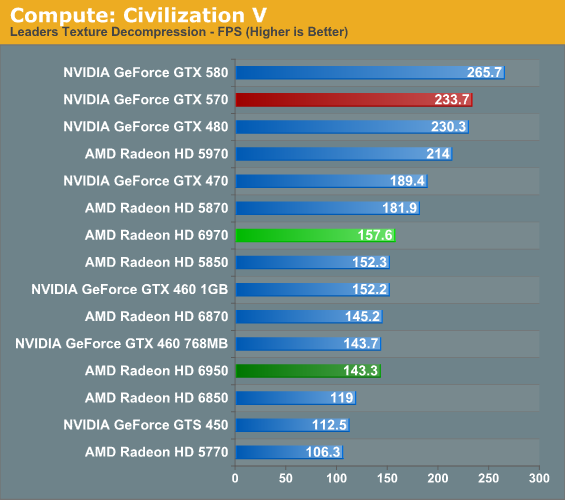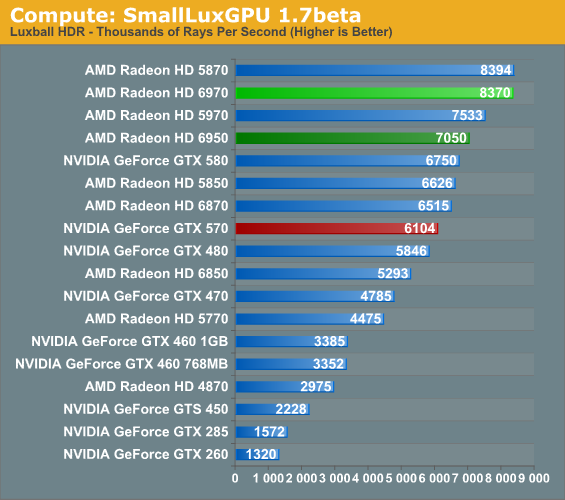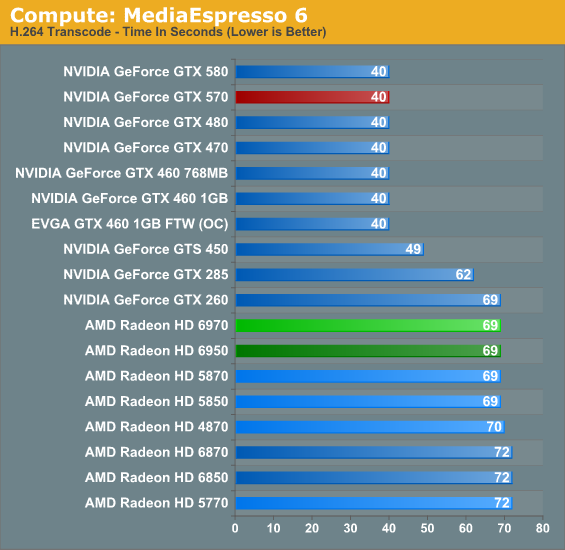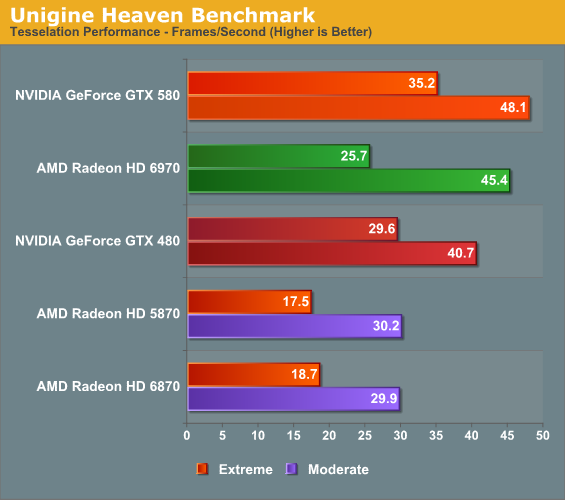AMD's Radeon HD 6970 & Radeon HD 6950: Paving The Future For AMD
by Ryan Smith on December 15, 2010 12:01 AM ESTCompute & Tessellation
Moving on from our look at gaming performance, we have our customary look at compute performance, bundled with a look at theoretical tessellation performance. This will give us our best chance to not only look at the theoretical aspects of AMD’s tessellation improvements, but to isolate shader performance to see whether AMD’s theoretical performance advantages and disadvantages from VLIW4 map out to real world scenarios.
Our first compute benchmark comes from Civilization V, which uses DirectCompute to decompress textures on the fly. Civ V includes a sub-benchmark that exclusively tests the speed of their texture decompression algorithm by repeatedly decompressing the textures required for one of the game’s leader scenes.

Civilization V’s compute shader benchmark has always benefitted NVIDIA, but that’s not the real story here. The real story is just how poorly the 6900 series does compared to the 5870. The 6970 barely does better than the 5850, meanwhile the 6950 is closest to NVIDIA’s GTX 460, the 768MB version. If what AMD says is true about the Cayman shader compiler needing some further optimization, then this is benchmark where that’s readily apparent. As an application of GPU computing, we’d expect the 6900 series to do at least somewhat better than the 5870, not notably worse.
Our second GPU compute benchmark is SmallLuxGPU, the GPU ray tracing branch of the open source LuxRender renderer. While it’s still in beta, SmallLuxGPU recently hit a milestone by implementing a complete ray tracing engine in OpenCL, allowing them to fully offload the process to the GPU. It’s this ray tracing engine we’re testing.

Unlike Civ 5, SmallLuxGPU’s performance is much closer to where things should be theoretically. Even with all of AMD’s shader changes both the 5870 and 6970 have a theoretical 2.7 TFLOPs of compute performance, and SmallLuxGPU backs up that number. The 5870 and 6970 are virtually tied, exactly where we’d expect our performance to be if everything is running under reasonably optimal conditions. Note that this means that the 6950 and 6970 both outperform the GTX 580 here, as SmallLuxGPU does a good job setting AMD’s drivers up to extract ILP out of the OpenCL kernel it uses.
Our final compute benchmark is Cyberlink’s MediaEspresso 6, the latest version of their GPU-accelerated video encoding suite. MediaEspresso 6 doesn’t currently utilize a common API, and instead has codepaths for both AMD’s APP and NVIDIA’s CUDA APIs, which gives us a chance to test each API with a common program bridging them. As we’ll see this doesn’t necessarily mean that MediaEspresso behaves similarly on both AMD and NVIDIA GPUs, but for MediaEspresso users it is what it is.

MediaEspresso 6 quickly gets CPU bottlenecked when paired with a faster GPU, leading to our clusters of results. For the 6900 series this mostly serves as a sanity check, proving that transcoding performance has not slipped even with AMD’s new architecture.
At the other end of the spectrum from GPU computing performance is GPU tessellation performance, used exclusively for graphical purposes. For the Radeon 6900 series, AMD significantly enhanced their tessellation by doubling up on tessellation units and the graphic engines they reside in, which can result in up to 3x the tessellation performance over the 5870. In order to analyze the performance of AMD’s enhanced tessellator, we’re using the Unigine Heaven benchmark and Microsoft’s DirectX 11 Detail Tessellation sample program to measure the tessellation performance of a few of our cards.

Since Heaven is a synthetic benchmark at the moment (the DX11 engine isn’t currently used in any games) we’re less concerned with performance relative to NVIDIA’s cards and more concerned with performance relative to the 5870. So with AMD’s tessellation improvements we see the 6970 shoot to life on this benchmark, coming in at nearly 50% faster than the 5870 at both moderate and extreme tessellation settings. This is actually on the low end of AMD’s theoretical tessellation performance improvements, but then even the geometrically overpowered GTX 580 doesn’t get such clear gains. But on that note while the 6970 does well at moderate tessellation levels, at extreme tessellation levels it still falls to the more potent GTX 400/500 series.

As for Microsoft’s DirectX 11 Detail Tessellation Sample program, a different story is going on. The 6970 once again shows significant gains over the 5870, but this time not against the 6870. With the 6870 implementing AMD’s tessellation factor optimized tessellator, most of the 6970’s improvements are already accounted for here. At the same time we can still easily see just how much of an advantage NVIDIA’s GTX 400/500 series still has in the theoretical tessellation department.










168 Comments
View All Comments
anactoraaron - Wednesday, December 15, 2010 - link
I would like to thank Ryan for the article that makes me forget the "OC card in the review" debacle. Fantastic in depth review with no real slant to team green or red. Critics go elsewhere please.Hrel - Wednesday, December 15, 2010 - link
When are you guys gonna put all these cards in bench? Some of them have been out for a relatively long time now and they're still not in bench. Please put them in there.ajlueke - Wednesday, December 15, 2010 - link
I agree with most of the conclusions I have read here. If you already own a 5800 series card, there isn't really enough here to warrant an upgrade. Some improved features and slightly improved FPS in games doesn't quite give the same upgrade incentive as the 5870 did compared a 4870.There are some cool things with the 6900 and 6800 series. Looking at the performance in games, the 6970 and even the 6870 seemed to get much closer to 2X performance when placed in crossfire as compared to 5800 series cards. That is a pretty interesting development. All in all, a good upgrade if you didn't buy a card last generation. If you did, it seems the wait is on for the 28 nm version of the GPU.
Belard - Wednesday, December 15, 2010 - link
NO!The 800 cards were the HIGH end models since the 3000 series and worked well through to the 5000 series with the 5970 being the "odd one" since the "X2" made more sense like the 4850X2.
It also allows for a "x900" series if needed.
AMD needs to NOT COPY Nvidia's naming games... did they hire someone from Nvidia? Even the GeForce 580/570 still belong to the 400 series since its the same tech. SHould have been named 490 and the 475... But hey, in 12 months, Nvidia will be up to the 700 series. Hey, Google Chrome is version 8.0 and its been on the market for about 2 years! WTF?!
What was their excuse again? Oh, to not create confusion with the 5700 series? So they frack up the whole model names for a mid-range card? The 6800's should have been 6700s, simple as that. Yes, there will be some people who will accidentally downgrade.
What the new 6000 series has going for AMD is that they are somewhat cheaper and easily cost less to make than the 5000s and what Nvidia makes.
In the end, the 6000 series is the first dumb-thing AMD has done since the 2000 series, but nowhere near as bad.
MS - Wednesday, December 15, 2010 - link
In terms of effienct usage of space though AMD is doing quite well; ... should be efficientNice article so far,
Regards,
Michael
nitrousoxide - Wednesday, December 15, 2010 - link
The power connector on the left (8-pin of 6970 and 6-pin of 6950) has a corner (bottom left corner) cut down, that's because the cooler doesn't fit with the PCB design, if you install it with force the power connector would get stuck. So the delay of 6900 Series could be due to this issue, AMD needs one month to 'manually polish' all power connectors of the stock-cards in order to go with the cooler. Well, just a joke, but this surely reflects how poorly AMD organizes the whole design and manufacture process :)nitrousoxide - Wednesday, December 15, 2010 - link
you can find this out here :)hiphotos. baidu. com/coreavc/pic/item/70f48d81ffe07cf26d811957. jpg
nitrousoxide - Wednesday, December 15, 2010 - link
AMD promises that every one will get a unique 6970 or 6950, different from any other card on the planet :)GummiRaccoon - Wednesday, December 15, 2010 - link
The performance of these cards is much better with 10.12, why didn't you test it with that?Ryan Smith - Wednesday, December 15, 2010 - link
10.12 does not support the 6900 series.8.79.6.2RC2, dated December 7th, were the absolute latest drivers for the 6900 series at the time of publication.